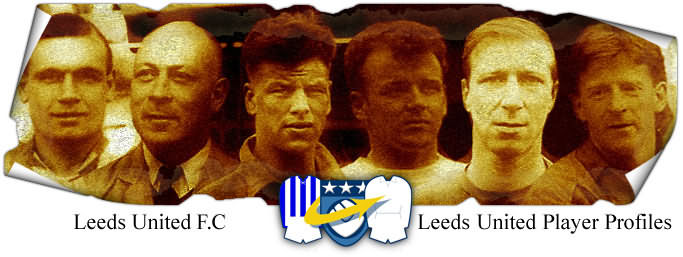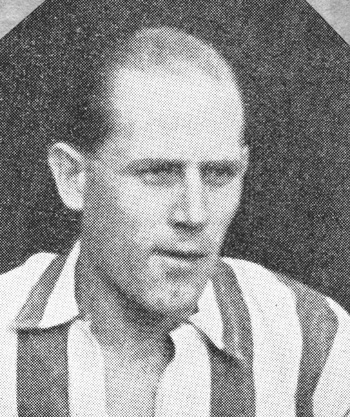

Wilkins: Ernest George (George)
1949-1949
(Player Details)
Inside Forward
Born: Hackney, London: 27-10-1919
Debut: Southampton (a): 09-09-1949
Height&Weight: Unknown
Wilkins was one of several Hayes players to make the grade with Brentford in the First
Division in the late 1930s. He was a nephew of goalkeeper Tom Holding and was coached by Alf
Sceeny as a boy. He went to Townfield School, where he played in the successful side which
won the Blaxland Cup for Middlesex schools, together with Mickey Dowse and Frank Rees. He
joined Hayes via Hayes Wasps and made his debut at outside-right on Easter Monday 1937 as a
sixteen-year-old in the 5-0 victory over Leyton. By now he was employed as a lorry boy. He
held his place for the Final of the London Senior Cup at Upton Park in May and was a regular
in the side for the 1937-8 season until he signed professional for Brentford, for whom he
broke his collar bone in May 1938, playing for their Junior side against Tottenham Hotspur.
He had made twenty-eight appearances for Hayes and scored nine goals. He joined Brentford in
February 1938, and, after making his First Division debut in January 1939, he played three
League games before the Second World War. He continued with the Griffin Park club during the
War, playing for them at Wembley in the 1942 London Cup Final, when the Bees beat Portsmouth.
He also played against Wolves in the Cup-Winners’ Cup match the same year. Meanwhile, he had
guested for Hayes in friendly matches at Christmas 1939, and had broken his collar bone
again against Fulham in October 1941. During the war, after being turned down by the Royal
Marines, he served in the Royal Kent Regiment, first of all near to London, and then he was
posted to Scotland. In 1944 he represented the British Army against the Yugoslav forces at
Bari, alongside Bryn Jones and Stan Cullis. When the League recommenced he was back with
Brentford and scored seven goals in twenty-six League games as Brentford lost their First
Division status in the first season after the War, along with Leeds. In February 1947,
before the season’s end, he joined Bradford Park Avenue for £7,000, but ten months later
after scoring six times in twenty-seven League games for the Second Division team, he was
transferred to another Second Division team, Nottingham Forest, for £7,500 on Boxing Day
1947. Six goals and twenty-four League games later he became a Leeds player in September
1949. He played three consecutive games at inside left, when Len Browning was injured and
Frank Dudley led the attack in his absence, but as soon as Browning returned Dudley took
over the inside left spot and Wilkins never played again and his career in the Football
League was ended. In December 1949 he returned to Hayes as coach, while working at Fairey
Aviation, and nearly played again for them. He received FA clearance to play in the FA Cup,
an open competition, against Hendon, but the Hayes committee withdrew him out of respect for
the purely amateur Athenian League team, and Hayes lost. In 1952 he was replaced as coach by
Len Townsend, a former colleague at Hayes and Brentford, after a dispute over the team
selection process, and he attempted a come-back as a player in the semi-professional Kent
League. In August 1953 he was reappointed in place of Townsend and continued until 1955,
when former skipper Dai Brown took his place. He was offered a column in the Hayes News,
which he used to undermine his successor and to reveal what was going on behind the scenes
at Church Road, aided by Hayes’ worst-ever start to a season. He was appointed coach again
in 1960, but was sacked in January 1961, when the players complained of his over-rigorous
training methods. By now he was the father four sons – Steve, Ray, Graham and Dean - and
two daughters. Unfortunately, when Ray was selected to captain England at Wembley in October
1982, George was too ill to watch. Only one of George’s five sons played for Hayes. The best
of them, Ray, had elected to sign for Chelsea and subsequently played for Manchester United,
AC Milan, Paris St Germain and Glasgow Rangers. Capped Eighty-four times by England, Ray
Managed Fulham and was then assistant coach to Gianluca Vialli at Chelsea and Watford before
becoming Assistant Manager to Denis Wise at Millward and then later returning as Assistant
Coach at Chelsea in February 2008, a position which he still holds. Steve Wilkins, however,
who also started at Chelsea and then went to Brentford but he failed to make the grade. He
then played for Dagenham and Walthamstow Avenue and joined Hayes in 1980 from Ruislip Manor
and spent two seasons, playing mainly in midfield. He made one hundred starts and made
another three appearances from the bench in scoring twenty-one goals. He went to Chesham
United in October 1982 and later played for Hendon, Farnborough Town, Ruislip Manor again,
Staines Town, where his brother Dean was player-coach, and Walton & Hersham. In addition to
Ray and Steve, he had two other sons, Graham and Dean, who also played League football.
Graham played over one hundred times for Chelsea and Dean was on Queens Park Rangers’ books.
George Wilkins died in 1999.